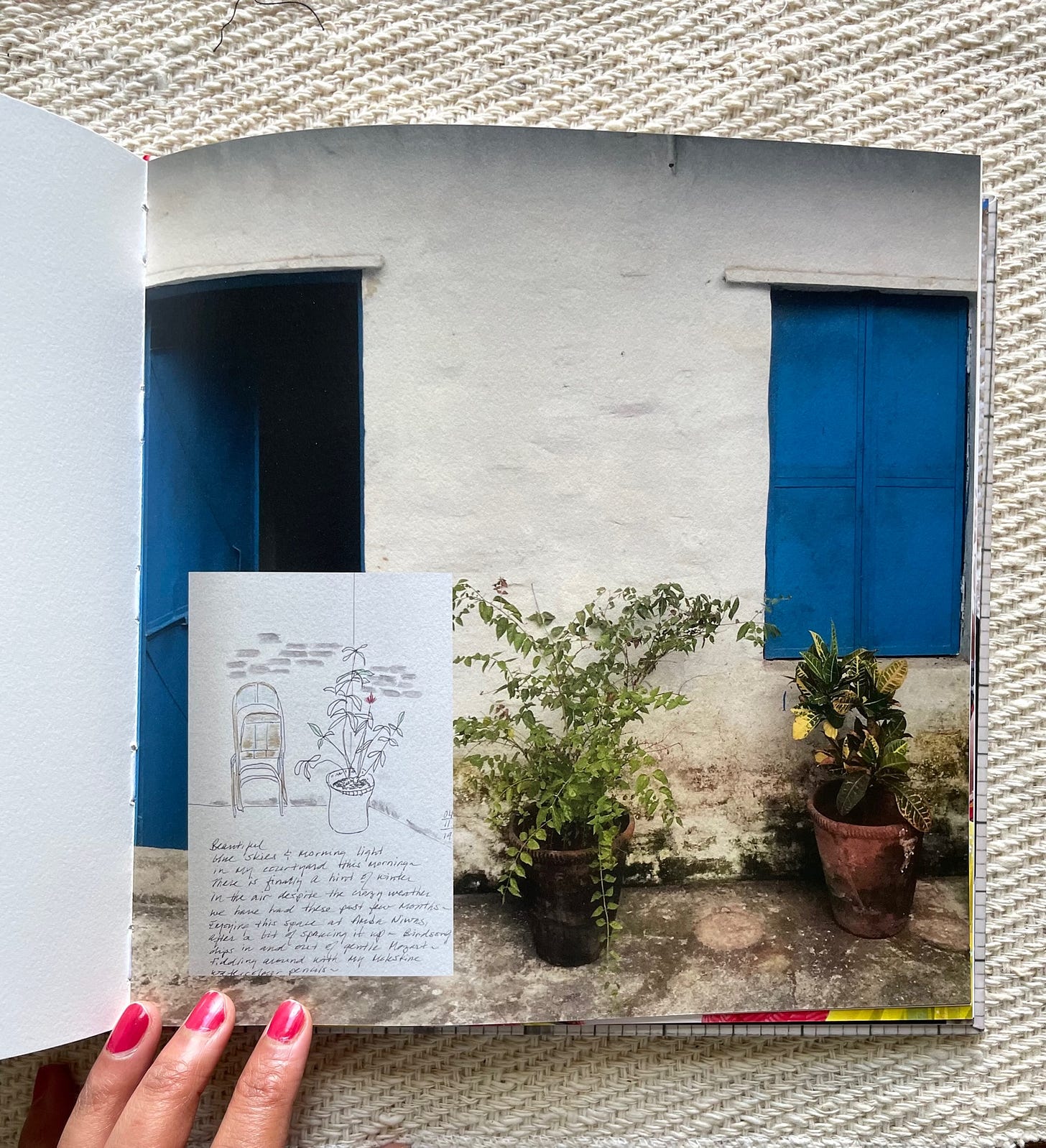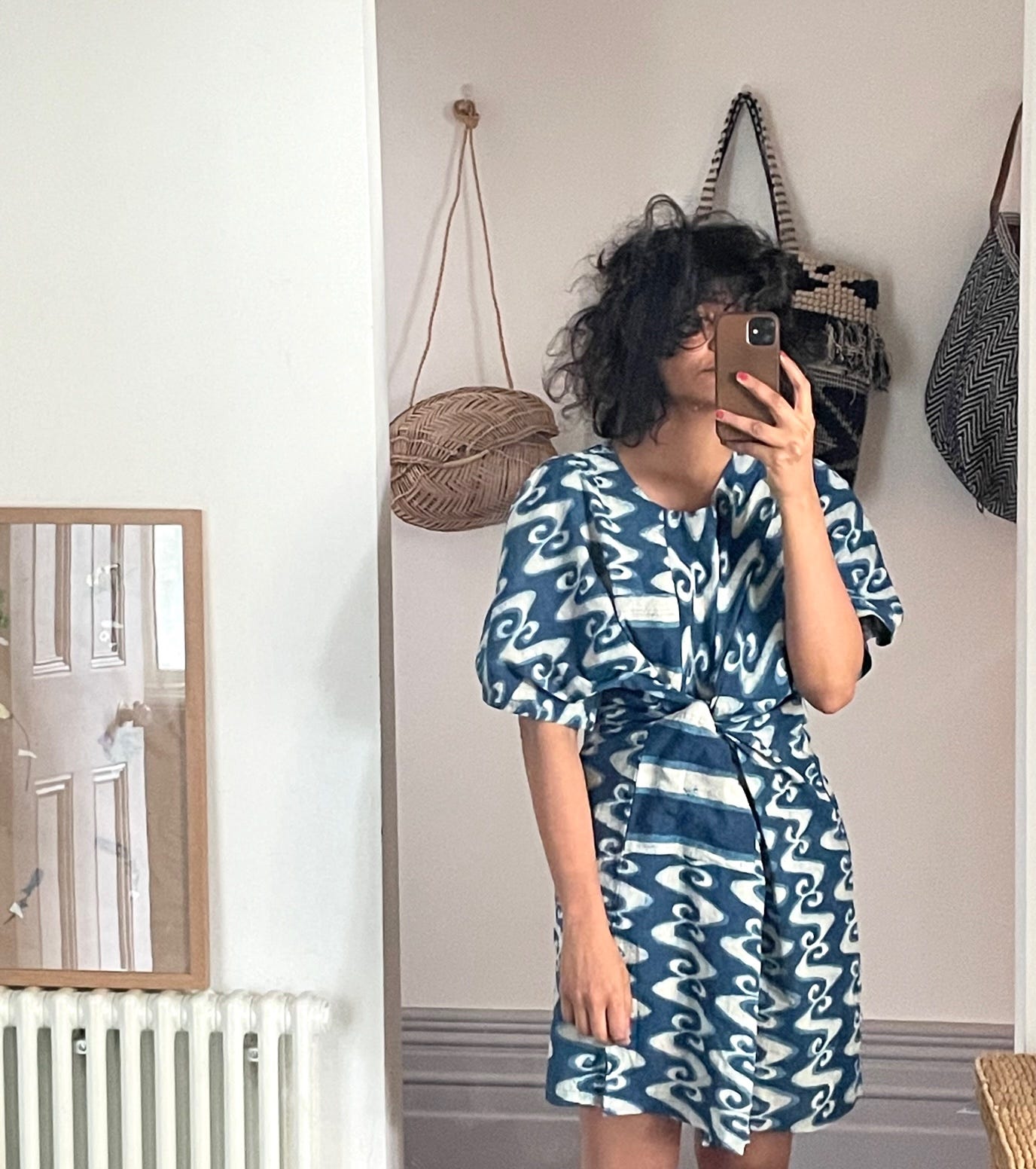Each time I receive responses to the questions I send for my open me carefully conversations - I am in awe. Each one so unique and incredibly thoughtful. I feel so honoured to know so many wonderful, creative and interesting people who make the time to share their way of seeing and thinking with me which I get to share with you.
I am mighty excited to introduce you to Hema, my very inspiring new artist/designer/entrepreneur friend who I love having conversations with. It started with her stumbling upon my work on instagram, and followed with me going through her textile journey in a city (Maheshwar) that she fell in love with on her first visit. The rest feels like an organic friendship—an unfolding of conversations about everything.
American by birth, India is Hema’s home now. She lives in Mumbai, and travels to Maheshwar (a city known for its weaving tradition) where she invests a lot of her time working with weavers at grass roots level that I really admire.
Through her very exclusive micro-batch clothing label, Amba, Hema works with the weavers of Maheshwar to create the most gorgeous textiles whilst also building sustainable systems entirely rooted in enabling the community she works in. I have always wondered why profit sharing with artisans isn’t a norm when a lot depends on their skill and craft. It makes me so happy to know that Hema has already thought about it, and practises it!
There is something so honest, direct, and poetic about how Hema expresses herself which I really love. Also, she is such a wonderful illustrator of moments.
Can’t wait for you to read Hema’s responses about things that move her, and how she goes about influencing change through her own textile practice.
ps - wherever possible have added links for better understanding of some culture-specific terms.
open me carefully : Hema Shroff Patel
What colour are you wearing today?
I am wearing much the same colour combination I wear everyday. Indigo low crotch pants and a long white tuxedo shirt.
Can you take me on a visual walk of things you love, see, and get inspired by around you in Mumbai and/or Maheshwar?
Visual delights: The way the light falls on the trees in Malabar Hill. The big old banyan tree across the road from our gate gives me so much pleasure and each Dusserah the same family comes from Gujarat each year to sell flowers and thorans (flower decoration) for this festival. Every Dusserah, I wake up and go for a walk in the morning. I meet the family from Gujarat who have set up their offerings the night before beside the banyan tree. The road is dotted with marigolds, a complete visual delight.
In Maheshwar i am such a sucker for all the quaint old buildings…so few are still standing. I love art. Recently I saw an exhibition of Raza’s old work, curated around the theme “Zamin: Homelands”.
What moved me most was his love for his birth state, Madhya Pradesh. He used to drive back to MP each year when he visited India. As he crossed the border he would pick up the soil in his hands and kiss the earth. Madhya Pradesh evokes a deep stirring in me. I felt that the first day I stood on the banks of the Narmada. I finally felt like I was home. I was so moved by the river and the majestic fort across the waters.
What does colour mean to you? Are there colours that you naturally gravitate towards? I’d love to hear a memory or story of a colour that holds a special place for you.
Sunsets on the Narmada also stir something inside of me…I have often gone back to this colour palette in my work. I gravitate to indigo. I gravitate to tone on tone. Hues within hues. Amba always has a limited colour palette. We are neutrals and cool tones with a hit of warm tones.
One of my favourite and deeper colour palettes was the one we selected for our Bundi collection. So much vibrancy came from these natural colour palettes where they crushed stones and other natural elements to make these amazing pigments.
I love that in your book you speak about the challenges of working with natural dyes. Do you feel the need to have more of these conversations to increase consumer awareness on natural dyes?
On the sustainability of natural dyes - more conversation is much needed. Everyone is "hash tagging" away about how natural dyes are so sustainable. They are not! It takes much water for the natural dye process over the azo free dye process. We recently had our team visit from Maheshwar and we visited Adiv Pure Nature and Rupa, the founder actually had this discussion with my artisans!
I heard something in your recent podcast that really resonated with me. You described Amba your micro-label as textiles that are thoughtful and intellectual, and deeply rooted in culture and aesthetics and has been since you started, way before sustainable was cool. Do you feel sometimes that the amount of consideration that you put into something gets diluted in the noise of sustainability of brands that are just better at shouting out loud without much substance?
On Amba’s journey as a micro label trying to be consistently thoughtful and work on intellectual projects - Initially I never thought about any of these hashtags. We just worked at the grass roots level, creating without even thinking about defining our work. Intuitively we knew we were doing good work and continued to strive to work on good practices and ethics. All the noise did disturb me at one point, but then a dear friend who works in the same space said, eventually all the noise will die down. Those of us working authentically will continue to do so and attract the right clients and patrons. It has not been easy for us to keep our heads above since the pandemic began. We have had to change our retail model. I cannot have large groups over to my home studio now and I am also busy with our social welfare activities in Maheshwar. So we do a lot of bespoke weaving for other small labels and companies. The collaborative process teaches all of us many things. Many organisations have learned from us what the true meaning of sustainability really is…for example, we are profit sharing with our team from the top down. We invest in our team to train them so they keep learning.
What would you change about the artisan/craftsperson and designer dynamic as it exists today?
Changing the perception consumers and outsiders have of the artisan is very important. In India, few people realise that our artisans are artists and intuitive designers. We have brought so much western thinking to deep rooted design philosophy which needs to change.
A book you'd gift anyone you meet
I love to read…there are so many, but I think I must settle on A Tree Grows in Brooklyn because there are so many little life lessons in this novel. I re-read the book again during lockdown. Francie has grit, and that is such an important quality during these extraordinary times, along with perseverance and hope.
What did you have to unlearn in your journey of starting up and following your passion?
Unlearning in my textile practice - following instructions to find perfection. Imperfection and mistakes create so much beauty. Coming from this boxed business background and working on a grid - warp and weft - can confine. What I had to learn is to create beauty from this confinement and there is not always a formula for that!
Write me a recipe so my senses can taste a bit of Maheshwar
Peanut chutney - crushed to perfection by Anubai
Crush a handful of peanuts with salt, pepper, dry kashmiri red chillies and a bit of burnt garlic (including a tiny bit of oil from the vagaar/tempering). Serve on the thali with daal, jowar roti and sabzi. Delish, but mine never tastes as good as Anubai’s.
I can’t wait to make my version of Anubai’s peanut chutney. Here’s a glimpse of Hema’s book for you. Full of colour, thoughts and process. A very refreshing perspective on textiles, sustainability and working with a community of artisans. If you’d like a copy of the book, you can write directly to Hema .
I wish you a gorgeous Saturday!
x asha
PS - here’s my Saturday vibe. It’s way too hot for my hair in London. And this is the Anokhi indigo dress I got in India this time around—too big for me so I knotted it and made it fashion.











